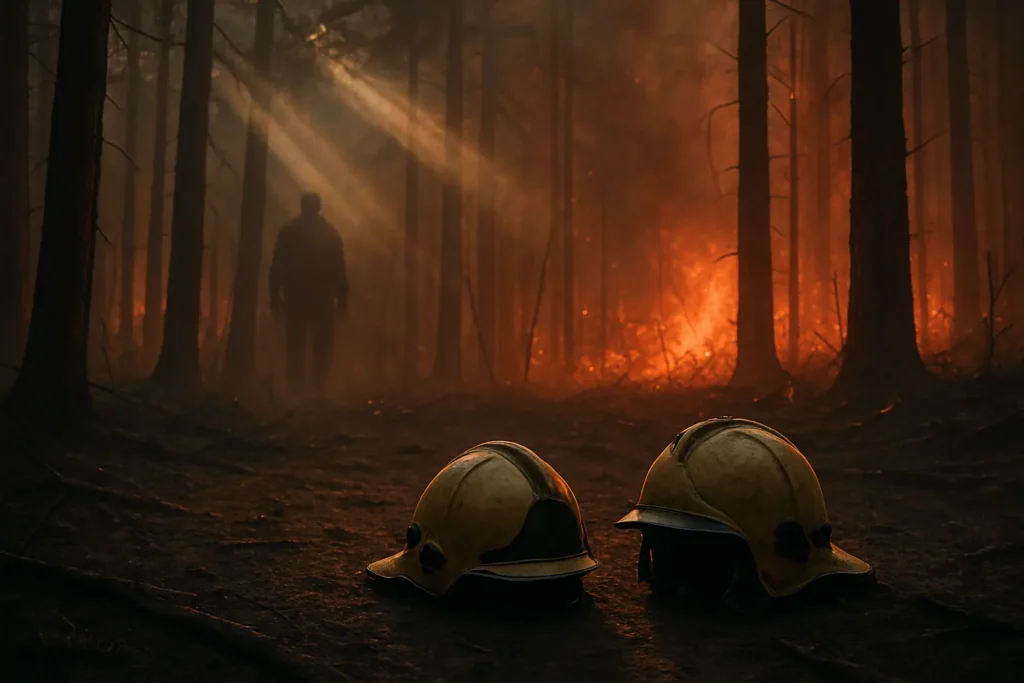Ambush Attack on Firefighters in Idaho
Two firefighters were tragically shot and killed near Coeur d’Alene, Idaho, after being ambushed by a sniper while responding to a deliberately set wildfire in the Canfield Mountain area. The deadly incident unfolded shortly after 1:20 pm when firefighters responded to reports of a brushfire. Approximately 40 minutes later, they came under heavy gunfire from an unidentified shooter positioned in dense brush, utilizing a high-powered rifle.
Sheriff Bob Norris of the Kootenai County Sheriff’s Office described the attacker’s positioning as highly strategic, pointing out that the individual was well-camouflaged within the terrain, complicating efforts to quickly identify and neutralize him. Radio transmissions from the scene captured the intensity and horror of the event, with firefighters urgently requesting backup and warning colleagues to withdraw from the danger zone.
The ambush resulted in two fatalities and left another first responder critically injured. Authorities acted swiftly, deploying over 300 officers, tactical units, and helicopters to secure the area and neutralize the threat. Using mobile phone data, law enforcement managed to pinpoint the sniper’s exact location later that evening.
“This is an intense, deliberate attack on first responders who were bravely rushing into danger to protect lives and property,” stated Sheriff Norris, expressing deep condolences to the families of the fallen firefighters.
Late Sunday night, a specialized tactical response team discovered the shooter’s lifeless body alongside a firearm. Authorities have not yet confirmed whether the sniper died from a self-inflicted gunshot or was killed by law enforcement.
Community Response and Ongoing Investigation
In response to the violent ambush, local authorities issued a shelter-in-place order for residents in the vicinity of Canfield Mountain. The lockdown was eventually lifted after the suspect’s death was confirmed, though the community remains deeply shaken by the incident’s brutal nature. Idaho Governor Brad Little described the event as a “heinous assault,” highlighting his condemnation and promising full support for first responders and families affected by this tragedy.
The fire, believed to have been an orchestrated attempt to lure first responders into a deadly trap, continued to burn through the immediate aftermath, further complicating emergency response efforts. Emergency crews worked courageously under distressing circumstances to control and later extinguish the blaze.
Kristi Noem, Secretary of the Department of Homeland Security, received a briefing on the incident, indicating heightened federal attention to the case, given its alarming implications for firefighter safety across the nation.
“This attack not only robbed us of brave community heroes but served as a grim reminder of the dangers our first responders face every day,” said Governor Little, pledging resources to strengthen security measures for emergency personnel.
The identities of the deceased firefighters have not yet been released, pending notification of next of kin. Meanwhile, the wounded firefighter has undergone surgery and is reported to be in stable condition, as the investigation into the shooter’s background and motivations continues.
Historical Context and Broader Implications
This incident adds to a distressing pattern of targeted attacks against emergency personnel, raising serious concerns about the vulnerability of first responders. Past events reveal similar tactics where assailants purposely set fires or enacted other emergencies to trap and harm firefighters and other frontline responders. One of the most notable examples occurred in 2012, when firefighters in Webster, New York, were ambushed by a gunman after responding to a fire that was intentionally set; two firefighters lost their lives, and two more were wounded in that incident.
Such attacks significantly impact policies regarding first responder safety and emergency response protocols nationwide. Agencies are continually revising operational strategies to enhance personnel security, considering measures such as improved communication systems, additional tactical training, and collaborative efforts with law enforcement during emergency incidents. These steps aim to anticipate potential threats and protect responder safety.
Statistics indicate that violence against emergency crews is a concerning trend nationwide. According to the National Fire Protection Association, incidents targeting firefighters have steadily increased over recent years. The Idaho shooting underscores the urgent need for policies addressing emergency responder vulnerabilities, fueling discussions on state and federal levels about improving safety standards for those who regularly risk their lives in public service.
“The safety and well-being of our firefighters and emergency responders must remain a national priority, emphasizing preparedness and preventive strategies,” noted a spokesperson from the National Fire Protection Association following the tragedy.
As the community mourns, this tragic event will likely serve as a critical impetus for policy discussions on protecting front-line responders from similar threats in the future. The investigation into the circumstances surrounding the Idaho ambush is still ongoing, with officials determined to uncover motives and ensure accountability.


